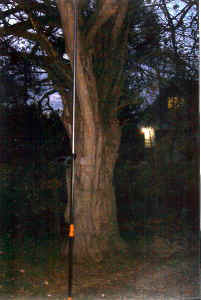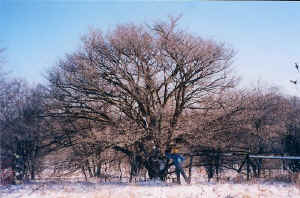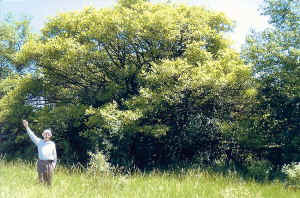|
==============================================================================
TOPIC: FW: Downy Hawthorn 4001 vs 8120
http://groups.google.com/group/entstrees/browse_thread/thread/8b33b8cb4e67d45a?hl=en
==============================================================================
== 1 of 4 ==
Date: Sun, Nov 11 2007 3:11 pm
From: "E. Daniel Ayres"
This is one of those situations where the accuracy of measurement
issues
come into play. I'm wondering if the Downy Hawthorn is one of those
trees
that just does not get much attention because it isn't that large or
long
lived? The one in Ann Arbor was for many years a "fence line
tree" and when
the fields to the east of it were no longer used as pasture, it
apparently
created several acres of hawthorn thicket downwind. Unfortunately
the area
is also a great example of the abililty of buckthorn to out compete
native
species. Many of the small hawthorns are now dying back and have
large
amounts of white and green fungal growth on the bark. Maybe I should
not be
calling attention to this variety as I strongly suspect that if
people were
seriously searching for a big one, these two would both get knocked
off the
list.
From: Dave Friedrichs
Sent: Sunday, November 11, 2007 4:13 PM
Subject: Downy Hawthorn 4001 vs 8120
Steve -
Pursuant to your visit to Ann Arbor and our recent discussions, I
would like
your assistance in obtaining official recognition of the A2 New as
either #1
- or as a "co" National Champion - Crataegus. The
co-champion designation
may be best for the time being, as both are similar in size YET
somewhat
different "models" of the Downy Hawthorne.
As this is National Champion designation is completed, I would ask
that the
Land Use Committee at my church, as owner, be the recipient of
whatever
certificate or other standard issue item is sent (by either
www.michbotclub.org < http://www.michbotclub.org/
> - or the national
certification authority). The address for our Land Use Committee is
below.
Their receipt of whatever might be sent will allow them to do
something
official to demarcate and commemorate the property's Downy
Hawthorne. (It
can be noted as well that this newly discovered Crataegus is truly a
Mother
(or Father) tree, as there are WELL OVER another 100 smaller downy
hawthorne's within 100 yards of the Champion tree.
On Saturday 11-10-07, I drove to Grosse Ile to see and measure
the tree
that has been listed as #1 Crataegus, address 8120 Macomb, Grosse
Ile.

8120 Macomb, Grosse Ile.,, MI |
 |
The tree is right on a main paved road at the address noted. (It
is
virtually a sidewalk tree, right next to the street and a driveway.)
The
house on the property is an empty 1950's ranch home with a detached
garage.
Although it was dusk, I took a few pictures and attach two here, for
reference of others. On the trunk, there is a faded (old) aluminum
plaque
from the Michigan Botanist Club.
Although others may also need to judge, the tree both in appearance
and
measurement comes in slightly less than the one on the grounds of
the church
@ 4001 A2-Saline Road. Instead of being 52' high as listed in the
Champion's listing, the Gross Ile tree is just 30' tall - i.e.,
virtually
the same as the A2 tree (which we now expect to straighten a bit due
to the
2007 removal of perimeter constraints and infused Buckthorns). The
girth of
the Grosse Ile tree is just under 100" - so A2's is greater (at
over 110" -
even figuring in the A2 tree's lower branching). [The one in Grosse
Ile has
no branch flares until about 6'-7' of trunk height -- so it is
different
than A2's in that regard). The average spread of the Grosse Ile
Crataegus
is about 40', i.e., also close to, but possibly somewhat less than
the
average spread of the A2 tree (our measurements averaging about
44').

4001 Ann Arbor Saline Road |

4001 Ann Arbor Saline Road, Richard Brown is
pictured |
To facilitate comparison, here too are a couple of pictures of
the tree @
4001 Ann Arbor Saline Road. If picture postings of National
Champions are
now possible, please use one or both of these. (The person pictured
is the
identifier of this A2 Downy Hawthorne, the late Richard I Brown.)
Thanks for your assistance in finalizing.
Best regards,
Dave Friedrichs
Chief Operating Officer
MeadowManagement, Inc
Owner Name & Address
Land Use Committee
First Unitarian Universalist Congregation of Ann Arbor
4001 Ann Arbor-Saline Road
Ann Arbor, Michigan 48108
== 2 of 4 ==
Date: Sun, Nov 11 2007 3:38 pm
From: James Parton
ENTS,
These are some impressive hawthorns! I have found sizeable ones in
Pisgah National Forest but none this massive. I know where one is
that
is close to 40 feet tall but it is not as broad thick & bushy as
these. I know of another that is about 8" in diameter and 20 ft
tall.
It is near Graveyard Fields just off the parkway here in WNC. I have
always had a liking for these unusual thorny trees.
James P.
== 3 of 4 ==
Date: Sun, Nov 11 2007 3:51 pm
From: edfrank@comcast.net
E. Daniel Ayres,
Those are some fantastic hawthorns. They should be submitted to
American Forests http://www.americanforests.org/resources/bigtrees/nomination.php
for consideration as National Champions - the remeasurements and the
new one. How were the heights measured? The girth of the tree that
is low branching should be measured below the lowest branch ) If it
is a single trunk specimen with low branches).
I would say almost without a doubt the species is not measured very
often because it is not very spectacualr in height. Dale, Tony, and
I submitted as a new national champ a dotted hawthorn only 39.3 feet
tall in the Allegheny River Wilderness here in PA. What I found
amusing is that these hawthorns started to catch my eye and I was
seeing them everywhere. On each island I visitedI found a bigger
one. http://www.nativetreesociety.org/fieldtrips/us_east/penna/ariw2007/ariw2007c.htm
The one submitted, Dale Luthringer actually walked by on an earlier
trip to the island, and did not notice theh slightly smaller ones on
Thompson island on the first day of our trip. People look for tall
trees and ignore the big- little trees until the fact is pointed out
to them.
Another problem is the difficulty in identifying the species of
hawthorn with which you are dealing. "This group is an
extremely large one with over 1,000 names having been applied to the
North American forms. There is little agreement as to the
differentiation of species and hybrids. For accurate identification,
both flowering material and material with ripe fruit must be
carefully examined." Some of the links I found about the
species is found on this page: http://www.nativetreesociety.org/species/sp_threads/hawthorn_dilemmas.htm
perhaps I will cc' them with this message. Thanks for forwarding
this message, I would like to see more of the smaller species
measured by ENTS and others.
Ed Frank
|